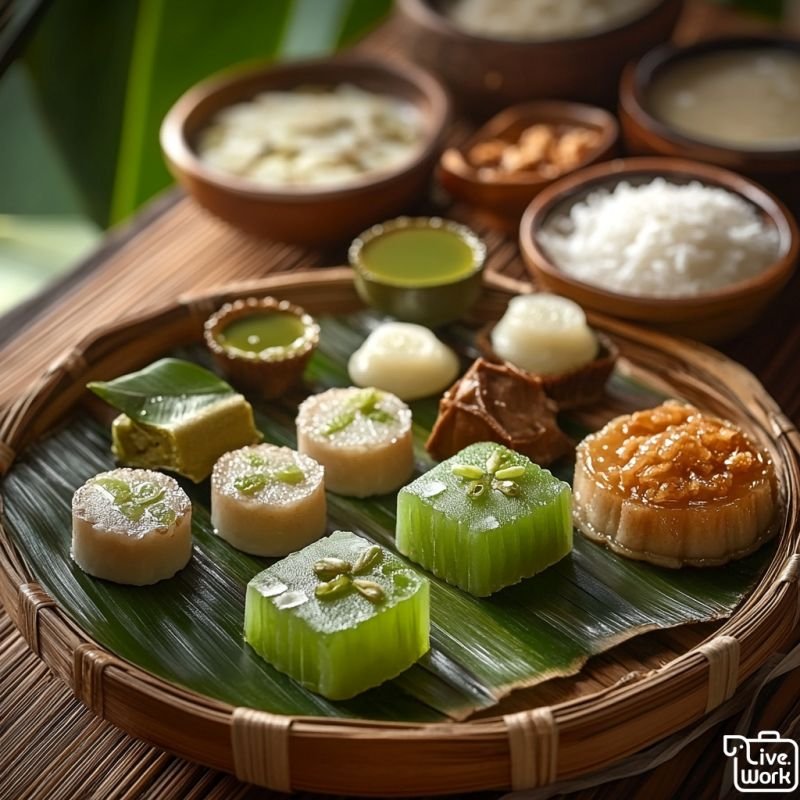Thai Desserts: A Sweet Taste of Culture, Craft, and Culinary Art
In Thailand, dessert is not just the end of a meal—it’s a celebration of beauty, balance, and cultural heritage. With their delicate textures, vivid colors, and fragrant ingredients, Thai desserts reflect the nation’s deep culinary traditions, Buddhist influences, and artistic sensibilities. Each sweet treat is a blend of natural bounty, centuries-old techniques, and symbolic meaning.
From market stalls to royal kitchens, Thai desserts offer a gastronomic journey that goes far beyond sugar. They represent a way of life—one that honors craftsmanship, seasonality, and harmony in every bite.
🌿 The Ingredients: Local, Fresh, and Fragrant
Thai desserts are crafted using simple, locally sourced ingredients that deliver rich and layered flavors:
Coconut milk – Adds creaminess and depth to almost every dessert.
Sticky rice (khao niao) – A staple ingredient, often steamed in banana leaves.
Palm sugar – A fragrant sweetener with caramel undertones.
Pandan leaf – Used for its natural green color and floral aroma.
Tropical fruits – Mango, banana, jackfruit, and durian feature prominently.
Egg yolks and mung beans – Especially in royal desserts with Portuguese influences.
These ingredients are transformed into sweets that are visually stunning, texturally diverse, and naturally satisfying—often without the use of dairy or wheat, making many Thai desserts naturally gluten-free and lactose-free.
🍧 Must-Try Traditional Thai Desserts
1. Khao Niao Mamuang (Mango Sticky Rice)
Perhaps Thailand’s most beloved dessert, this dish combines sweet glutinous rice, ripe mango slices, and a generous drizzle of coconut cream.
Served seasonally during mango harvest, especially from March to June.
Why it’s special: It showcases the Thai mastery of balancing sweet, salty, and creamy in a single dish.
2. Thong Yip, Thong Yod, and Foi Thong (The Golden Trio)
Royal Thai desserts made from egg yolks and syrup, introduced by Portuguese settlers in the 17th century.
"Thong" means gold—these desserts symbolize wealth, luck, and prosperity.
Often given as gifts during weddings and auspicious ceremonies.
Why it’s special: Their delicate preparation and symbolism reflect Thailand’s connection between food and fortune.
3. Khanom Buang (Thai Crispy Pancakes)
Tiny taco-like treats filled with sweet or savory toppings.
The shell is crispy and golden, the filling typically includes sweetened egg floss and coconut cream.
Commonly found at street food markets.
Why it’s special: Combines texture, artistry, and the fun of street food culture.
4. Tub Tim Krob (Red Rubies)
Chilled dessert made of water chestnuts coated in tapioca, served in sweetened coconut milk with crushed ice.
Refreshing and perfect for hot Thai days.
Why it’s special: It’s a playful mix of crunch and creaminess, with striking ruby-red visuals.
5. Khanom Chan (Layered Coconut Jelly)
A nine-layered steamed dessert made from rice flour, tapioca flour, and coconut milk.
Each layer is symbolically tied to longevity and progression, often used in blessings.
Why it’s special: Its vibrant colors and layered texture make it both beautiful and symbolic.
🎎 Dessert in Thai Culture
In Thai tradition, desserts are more than indulgence:
They are often served at religious offerings, weddings, and celebrations.
Names and shapes are often auspicious, reflecting Thai beliefs in luck, beauty, and harmony.
Many desserts are handcrafted with intricate detail, making their preparation a form of culinary artistry.
Thai desserts are also a way to connect generations, with recipes passed down through families and regional specialties preserved with pride.
🍽 Where to Find Thai Desserts
Street food stalls: Khanom buang, sticky rice variations, and fruit-based treats.
Night markets and floating markets: A rich variety of sweets sold fresh and affordably.
Thai restaurants and dessert cafes: Elegant presentations of traditional favorites and fusion interpretations.
Festivals and religious events: Homemade desserts made specially for sharing and merit-making.
👨🍳 Making Thai Desserts at Home
Many Thai desserts are surprisingly simple to prepare with the right ingredients:
Sticky rice and mango require only soaking, steaming, and coconut milk infusion.
Layered jellies or tapioca pearls offer fun, colorful cooking projects for families.
Look for Thai dessert kits or recipes online to bring a bit of Thailand into your kitchen.
Final Thoughts: A Sweet Window into Thai Heritage
From royal banquet tables to floating markets, Thai desserts are a testament to Thailand’s love for beauty, balance, and flavor. Each dish carries with it a story—of place, of celebration, of community.
